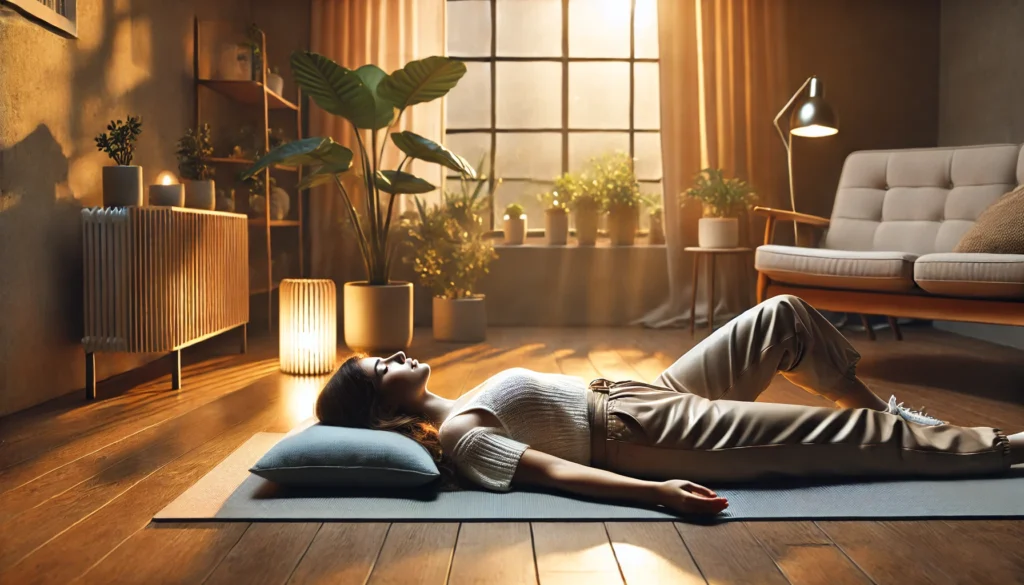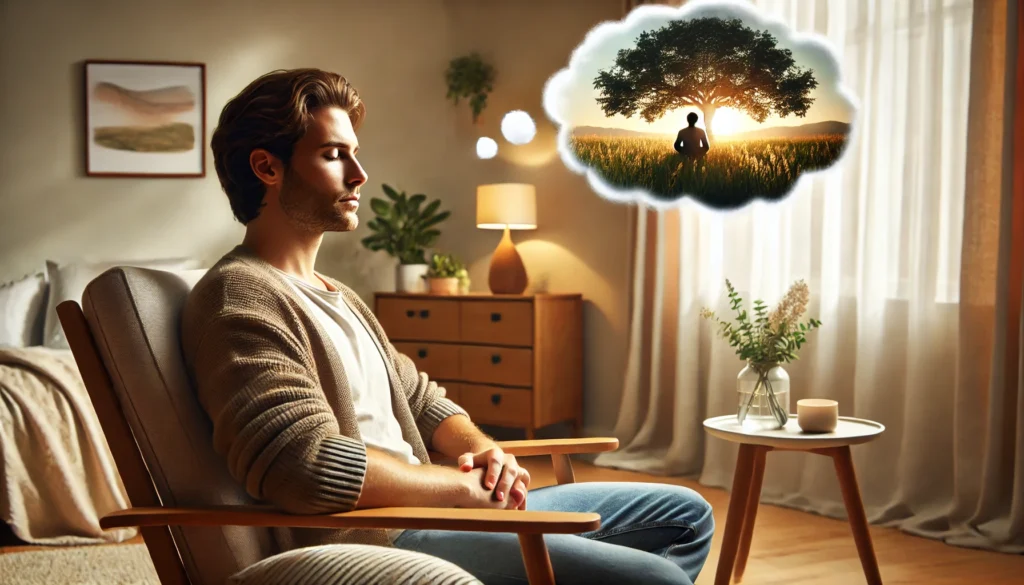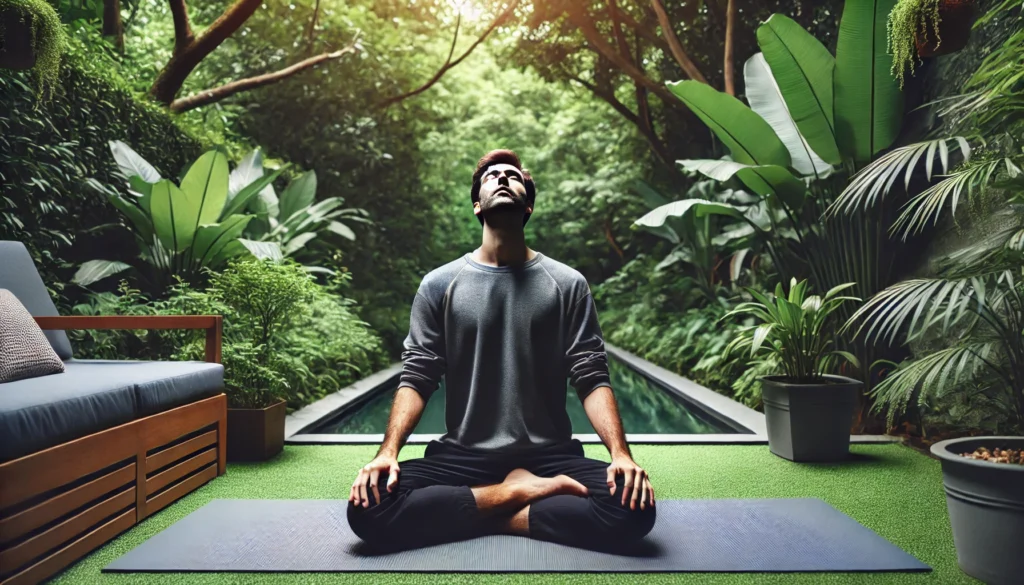Cognitive Behavioral Therapy, a well-established psychological intervention, focuses on changing unhelpful cognitive distortions and behaviors, enhancing emotional regulation, and developing personal coping strategies. Relaxation techniques within CBT are integral in helping individuals manage stress and anxiety symptoms effectively.
You may also like: Stress Relief: Sentences to Calm Your Mind
Defining Cognitive Behavioral Therapy
CBT is a form of psychotherapy that emphasizes the role of thinking in how we feel and what we do. It is based on the cognitive model, which suggests that our thoughts, feelings, and behaviors are interconnected. By identifying and altering negative thought patterns, CBT aims to bring about changes in mood and behavior.
The Role of Relaxation in CBT
Relaxation techniques serve as a fundamental component within the CBT framework, targeting the physiological manifestations of stress and anxiety. These techniques provide clients with practical tools to calm their nervous system and reduce the physical symptoms of anxiety, such as increased heart rate and muscle tension.
Benefits of Integrating Relaxation Techniques
Integrating relaxation techniques into CBT offers multiple benefits. It enhances the therapeutic process by addressing both the cognitive and physiological aspects of anxiety. Moreover, it empowers clients by equipping them with skills they can use autonomously, fostering a sense of control and self-efficacy in managing their mental health.
The Historical Context of CBT Relaxation Techniques
CBT’s origins can be traced back to the 1960s when Aaron Beck introduced the concept of cognitive therapy. The incorporation of relaxation techniques into CBT emerged as therapists recognized the need to address the physiological symptoms of stress and anxiety alongside cognitive elements. Over the decades, these techniques have evolved, becoming a staple in therapeutic settings, offering clients practical tools to manage their mental health.
Early Developments in CBT
The 1960s marked a pivotal era for psychotherapy with Aaron Beck’s introduction of cognitive therapy. Initially focused on depression, Beck’s approach highlighted the importance of identifying distorted thinking patterns. As CBT gained recognition, therapists began incorporating relaxation techniques to address the physical symptoms of anxiety and stress.
Evolution of Relaxation Techniques
Over the years, relaxation techniques have evolved from simple breathing exercises to more sophisticated methods like guided imagery and progressive muscle relaxation. Early adopters of CBT relaxation techniques sought to integrate these methods to create a more comprehensive approach to therapy, addressing both mind and body.
Influence of Research and Clinical Practice
Research in psychology and neuroscience has significantly influenced the development of relaxation techniques within CBT. Clinical studies have demonstrated the efficacy of these techniques in reducing anxiety and stress, prompting therapists to incorporate them into their practices. This evolution reflects a growing understanding of the interconnectedness of mental and physical health.

Current Trends in CBT Relaxation Techniques
In today’s fast-paced world, the demand for effective anxiety management tools has never been higher. CBT relaxation techniques, including breathing exercises, progressive muscle relaxation, and guided imagery, are increasingly being integrated into therapy sessions. These methods not only help in reducing anxiety but also empower clients by providing them with skills they can use independently outside of therapy.
Breathing Exercises and Their Popularity
Breathing exercises have become a cornerstone of CBT relaxation techniques due to their simplicity and effectiveness. Techniques like diaphragmatic breathing and the 4-7-8 method are popular choices for therapists. These exercises are easily taught and practiced, making them accessible tools for anxiety management.
Progressive Muscle Relaxation in Therapy
Progressive muscle relaxation (PMR) is another widely used technique, helping individuals become more aware of their physiological responses to stress. By systematically tensing and relaxing muscle groups, PMR aids in reducing muscle tension and promoting relaxation. Therapists often integrate PMR into sessions to help clients recognize and alter their stress responses.
Guided Imagery and Its Applications
Guided imagery involves visualizing calming scenarios to promote relaxation. This technique engages the imagination, creating a mental escape from stressors. Therapists utilize guided imagery to help clients develop a repertoire of peaceful images they can access during moments of anxiety, enhancing their ability to self-regulate.
Key CBT Relaxation Techniques
CBT Breathing Techniques for Anxiety
One of the fundamental relaxation techniques in CBT is controlled breathing, often referred to as diaphragmatic or deep breathing. This technique involves taking slow, deep breaths, which can help reduce anxiety by calming the body’s stress response.
Diaphragmatic Breathing: A Deep Dive
Diaphragmatic breathing focuses on engaging the diaphragm for deeper breaths. Clients are encouraged to place one hand on the chest and the other on the abdomen, ensuring the stomach rises more than the chest. This method promotes relaxation by enhancing oxygen flow and reducing stress hormones.
The 4-7-8 Breathing Technique
The 4-7-8 technique is a structured breathing exercise that can be easily incorporated into daily routines. By inhaling for four counts, holding for seven, and exhaling for eight, clients can shift their focus away from anxiety-inducing thoughts. This technique is particularly beneficial for nighttime relaxation and stress reduction.
Breathing Techniques in Practice
Therapists often guide clients through breathing exercises during sessions, providing immediate relief from anxiety symptoms. Encouraging clients to practice these techniques regularly enhances their effectiveness, allowing individuals to manage stress proactively.
Progressive Muscle Relaxation
Progressive muscle relaxation involves systematically tensing and then relaxing different muscle groups in the body. This technique helps individuals become more aware of physical sensations associated with tension and relaxation, promoting a state of calmness.
Step-by-Step Guide to PMR
Progressive muscle relaxation begins with the toes, gradually working up the body. Clients are instructed to tense each muscle group for a few seconds before releasing. This process continues through the legs, abdomen, arms, neck, and facial muscles, fostering awareness of tension and relaxation.
Benefits of Progressive Muscle Relaxation
PMR not only reduces physical tension but also enhances mental clarity. By focusing on the contrast between tension and relaxation, clients learn to identify stress triggers and develop coping strategies. This technique can be particularly useful for individuals with chronic stress or muscle tension.
Incorporating PMR into Daily Life
Therapists encourage clients to practice PMR outside of therapy to maximize its benefits. Regular practice can lead to increased relaxation and stress resilience, empowering individuals to manage anxiety more effectively in various situations.
Guided Imagery
Guided imagery is a CBT relaxation technique that involves visualizing calming images or scenarios to promote relaxation and reduce stress. This method engages the imagination to elicit a state of relaxation and mental peace.
Practicing Guided Imagery
To practice guided imagery, clients find a quiet space and close their eyes. They are guided to imagine a serene environment, such as a beach or forest, and focus on the sensory experiences associated with that place. This immersive visualization fosters relaxation by diverting attention from stressors.
Therapeutic Applications of Guided Imagery
Guided imagery is a versatile tool in therapy, aiding in stress reduction and emotional regulation. Therapists often tailor visualizations to suit individual preferences, enhancing engagement and effectiveness. This technique can also be used to prepare clients for challenging situations, boosting confidence and reducing anxiety.
Guided Imagery in Group Settings
Group therapy sessions can benefit from guided imagery, creating a shared experience of relaxation. Participants are guided through the visualization, fostering a sense of community and support. This collective practice can enhance group cohesion and provide additional motivation for individuals to engage in relaxation techniques.

The Role of CBT Relaxation Techniques in Managing GAD
Individuals with Generalized Anxiety Disorder (GAD) often experience persistent and excessive worry. CBT relaxation techniques play a crucial role in managing GAD by reducing the physiological symptoms of anxiety and helping individuals regain control over their emotional responses.
Understanding Generalized Anxiety Disorder
GAD is characterized by chronic and exaggerated worry about everyday events. This condition can significantly impact an individual’s daily life, leading to physical symptoms such as restlessness, fatigue, and muscle tension. Understanding the nature of GAD is essential for effective therapeutic intervention.
Customizing Relaxation Techniques for GAD
Therapists tailor relaxation techniques to meet the unique needs of clients with GAD. By customizing exercises, therapists ensure that clients receive the most effective tools for managing their symptoms. This personalized approach enhances client engagement and promotes better outcomes.
Combining Relaxation with Cognitive Strategies
Integrating relaxation techniques with cognitive strategies provides a comprehensive approach to managing GAD. By addressing both the cognitive and physiological aspects of anxiety, therapists help clients develop a balanced skill set for managing their condition. This holistic approach fosters long-term resilience and emotional well-being.
Future Implications and Innovations
As research in psychology and neuroscience advances, the integration of technology into CBT relaxation techniques is becoming more prevalent. Virtual reality (VR) and mobile applications are being developed to enhance the delivery and accessibility of these techniques, offering interactive and immersive experiences for users.
Virtual Reality and CBT Relaxation
VR technology has the potential to revolutionize how relaxation techniques are taught and practiced. By creating immersive environments, VR can simulate calming scenarios, providing users with a novel and engaging way to practice relaxation exercises.
Benefits of VR in Therapy
Virtual reality offers a unique opportunity to simulate real-world scenarios in a controlled environment. This technology can help clients practice relaxation techniques in settings that mimic their daily lives, enhancing the transfer of skills from therapy to real-world situations.
Developing VR Relaxation Programs
Developing effective VR relaxation programs requires collaboration between therapists, researchers, and technology developers. By combining expertise from these fields, VR programs can be tailored to address specific therapeutic goals and client needs, maximizing their impact on mental health.
Challenges and Considerations
While VR holds promise, there are challenges to its integration into therapy. Cost, accessibility, and user comfort are important considerations. Addressing these challenges will be essential to ensure that VR relaxation techniques are accessible and beneficial to a wide range of clients.
Mobile Applications for CBT
The rise of digital health solutions has led to the development of mobile applications designed to guide users through CBT relaxation techniques. These apps offer convenience and accessibility, allowing individuals to practice relaxation exercises anytime, anywhere.
Features of CBT Mobile Apps
CBT mobile applications often include a variety of relaxation exercises, from breathing techniques to guided imagery. These apps provide step-by-step instructions and reminders, supporting users in developing consistent relaxation practices and integrating them into their daily routines.
Enhancing Accessibility and Engagement
Mobile apps make relaxation techniques accessible to individuals who may not have regular access to therapy. By offering interactive and user-friendly interfaces, these apps engage users and encourage consistent practice, fostering better mental health outcomes.
Future Directions for CBT Apps
As technology evolves, CBT apps are likely to incorporate more personalized features, such as adaptive content and real-time feedback. These advancements will enhance user engagement and effectiveness, making CBT relaxation techniques more accessible and impactful.

Conclusion
Integrating CBT relaxation techniques into therapy provides a holistic approach to managing anxiety and stress. By understanding the historical context, current trends, and potential future developments of these techniques, health and wellness professionals can offer clients effective tools for improving their mental health.
As the field of psychology continues to evolve, embracing innovations in technology and research will be essential in enhancing the efficacy and accessibility of CBT relaxation techniques, ultimately promoting better mental health outcomes for individuals worldwide. By continuously adapting and expanding these techniques, therapists can ensure that clients receive the most effective and relevant support for their mental health needs.
Further Reading:
Important Note: The information contained in this article is for general informational purposes only, and should not be construed as health or medical advice, nor is it intended to diagnose, prevent, treat, or cure any disease or health condition. Before embarking on any diet, fitness regimen, or program of nutritional supplementation, it is advisable to consult your healthcare professional in order to determine its safety and probable efficacy in terms of your individual state of health.
Regarding Nutritional Supplements Or Other Non-Prescription Health Products: If any nutritional supplements or other non-prescription health products are mentioned in the foregoing article, any claims or statements made about them have not been evaluated by the U.S. Food and Drug Administration, and such nutritional supplements or other health products are not intended to diagnose, treat, cure, or prevent any disease.


